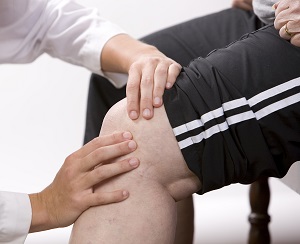
A complete physical examination of the knee is performed when you present to your doctor with a knee complaint. Both of your knees are examined and the results of the injured knee are compared to those of the healthy knee.
Physical examination
Initially, your doctor will inspect your knees for any changes in the skin, swelling, redness, and deformity. The doctor will also feel your knee for warmth, coolness tenderness, blood flow, and sensation. Your knees will be tested for a range of motion and production of any sounds such as grinding, popping or clicking by moving it around.
Tests
Some tests may be conducted to examine the knee ligaments; these include:
- Valgus and varus tests: checks the lateral and medial collateral ligaments (ligaments on either side of the knee joint that help in back and forth movement of the knee). In this test, your doctor holds your knee joint with one hand and the ankle joint with the other and moves your leg sideways.
- Posterior drawer test/anterior drawer test: checks the posterior/anterior cruciate ligament (ligaments inside your knee joint that help in the sideways movement of the knee). In this test, you are made to lie on your back with your knee bent to a 90-degree angle and your foot flat on the table. Your doctor holds your leg just below the knee and pushes it back on your leg.
- Pivotal shift test: examines the anterior cruciate ligament (ACL). Your leg is stretched out. Your doctor holds your calf and twists the knee towards the body.
Spongy tissue called the cartilage or menisci that cushions the knee joint may also be examined for damage. A McMurray test may be performed when your doctor suspects a problem with your menisci. During the test, you will lie on the table. Your doctor holds your knee and bottom of the foot, pushes your leg up to bend your knee and rotates your leg. If there is any pain or clicking sound, the meniscus may be damaged.
Arthrometric testing is another test that may be performed to measure the looseness of your knee. This procedure uses an arthrometer (an instrument that measures the range of movement) and is employed when pain or physical size makes it difficult to perform a physical examination.
Results
The results of the knee examination vary based on whether the examination is for a sudden injury, recurrent or long-lasting problem. Abnormal findings do not always imply that you have a knee injury. Your doctor makes a diagnosis based on both the test results as well as your medical history.










